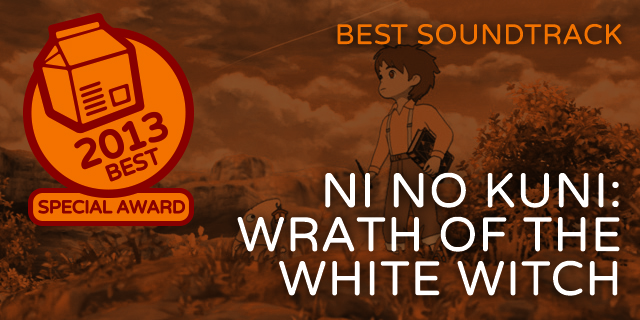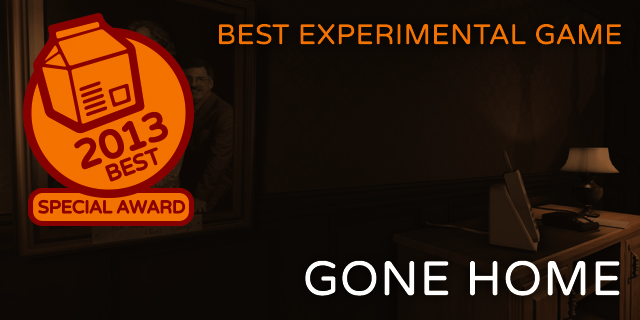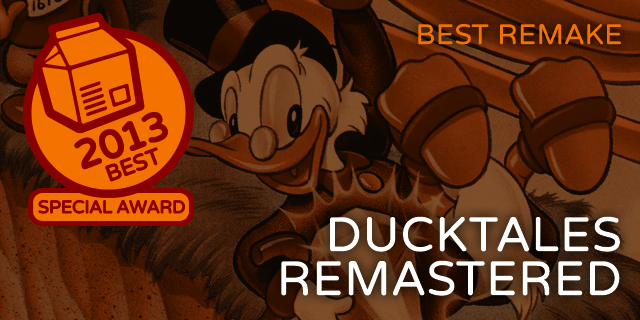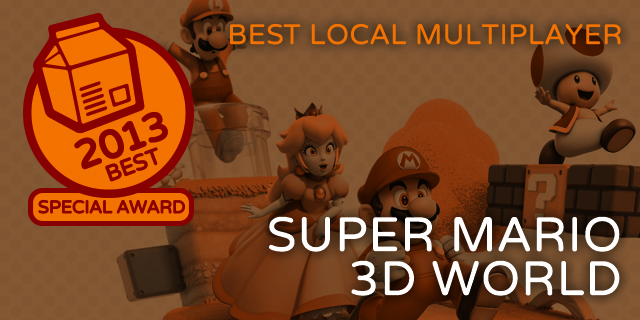
This year, we decided to do something special: allow staff to choose award categories of their own to join our end-of-year festivities. In this first half, we name 2013’s best game soundtrack, best remake, best experimental game and best local multiplayer title.

 While some gravitate towards base gameplay mechanics, visuals, or writing, it’s the music that always stands out to me. An excellent game score can elevate a pretty solid title into something worth remembering, and the best soundtracks can bring you back to the experience of playing the game just by listening. In a year full of some incredible scores, it’s time to honor the best soundtracks the gaming industry had to offer us. – Andrew Passafiume
While some gravitate towards base gameplay mechanics, visuals, or writing, it’s the music that always stands out to me. An excellent game score can elevate a pretty solid title into something worth remembering, and the best soundtracks can bring you back to the experience of playing the game just by listening. In a year full of some incredible scores, it’s time to honor the best soundtracks the gaming industry had to offer us. – Andrew Passafiume
When looking at soundtracks, I don’t necessarily look at overall quality. To me, a good soundtrack will have multiple songs that are standouts. Ni no Kuni‘s impossibly-beautiful visuals are matched with an equally good soundtrack. “Over the Waves,” a song you hear when you traverse the glorious overworld map, is reminiscent of a classic RPG tune. It feels like a mix of Dragon Quest and Final Fantasy. What higher compliment can I give? Or how about “Ara Memoriae,” which treads carefully close to masterpiece status. I’d be at the receiving end of a beating from Porco if I didn’t mention “Taking to the Skies.” You hear this when you get to fly across the world on the back of a dragon. It’s impossible not to get a surge of power from listening to the first twenty seconds as you soar over all the rivers and plains of Ni no Kuni‘s lush, spectacular overworld. – Henry Skey

Runner-up: Rayman Legends
It’s rare that a game manages to put together licensed songs in a way that feels original, but Legends‘ music-based levels are exactly this sort of uncommon alchemy. Paired with a slate of original tunes that embrace the role of a backdrop and don’t disrupt as much as they did in Origins, and you have an experience that’s just as fun for the people in the next room as it is for the players. (Well, almost.) – Graham Russell

 Stagnation is the fastest path to irrelevance. In any creative field, artists must constantly work to push the boundaries of their media to go places yet unseen. This is especially important in our relatively-nascent medium of interactive experiences, as we have only just begun to explore its artistic and cultural potential. This is why we must pay homage to the artists in the trenches of game creation: to let them know that their efforts are greatly appreciated. – Chris Dominowski
Stagnation is the fastest path to irrelevance. In any creative field, artists must constantly work to push the boundaries of their media to go places yet unseen. This is especially important in our relatively-nascent medium of interactive experiences, as we have only just begun to explore its artistic and cultural potential. This is why we must pay homage to the artists in the trenches of game creation: to let them know that their efforts are greatly appreciated. – Chris Dominowski
Gone Home isn’t the first game to experiment with exploration and environmental storytelling, but it’s easily the best. It features little gameplay and is an adventure game in the most basic sense, stripping away everything but your ability to explore and examine the world around you. As a result, it brings the game’s brilliant story to the forefront and allows it room to breathe, but it doesn’t make the act of playing it any less compelling. – Andrew Passafiume

Runner-up: The Stanley Parable
The Stanley Parable is thought-provoking in a way that few other games are. There’s no combat, there are no puzzles. There’s really no gameplay at all. Stanley simply explores and listens to the ramblings of the narrator. I’ve written this paragraph over and over and backspaced it every time, because I make The Stanley Parable sound boring, and I promise you that it’s not. It’s engrossing and interesting, and it makes my head hurt. I really wish that I could explain what makes it great without giving things away, but I can’t. Everybody should experience The Stanley Parable. You’ll be at the same loss for words that I am, and you’ll be better for it. – Justin Last

 Remakes are a touchy subject in many cases. With film, it’s often to update a story with modern influences or to add new special effects to an old story. But older films are also readily available in several formats. With games, the differences between the original and the remake are much more apparent. Visual quality improves, of course, but unlike films, games also change things like control scheme, mechanics, new play styles and (potentially) online play. A good remake offers an update that justifies the effort that went into it, instead of simply existing to give a game another round on store shelves. – Jeff deSolla
Remakes are a touchy subject in many cases. With film, it’s often to update a story with modern influences or to add new special effects to an old story. But older films are also readily available in several formats. With games, the differences between the original and the remake are much more apparent. Visual quality improves, of course, but unlike films, games also change things like control scheme, mechanics, new play styles and (potentially) online play. A good remake offers an update that justifies the effort that went into it, instead of simply existing to give a game another round on store shelves. – Jeff deSolla
When DuckTales Remastered was first revealed, I remember showing the trailer to a friend of mine over a decade my junior and his response was “really?”. He couldn’t know. But I knew, as did all of those PAX East attendees singing along to the timeless theme song: one of the most awesome NES games ever made, and quite possibly the best licensed title in the history of gaming was coming back. Remastered looked amazing, sounded incredible — especially considering the advancing age of the original voice actors — and was for the most part as flawless as a twelve-year-old kid now in his mid-thirties remembered it to be. Sure, the new content at the end of the game was perhaps more difficult than it needed to be, but considering how anti-climactic the end of the original game was, there was definitely room for improvement on that front. WayForward does good work when it comes to taking NES classics and making them look modern, while retaining what made the original gameplay special (see also: A Boy and His Blob), and I hope to see more of this kind of thing from the developer in the future. – Chris Ingersoll

Runner-up: Shin Megami Tensei: Devil Summoner: Soul Hackers
The never-before-localized Sega Saturn classic returned this year, thanks to the good folks at Atlus. A gutsy release even by Atlus standards, Soul Hackers was a first-person dungeon crawler (a subgenre considered all but dead) spin-off of the Shin Megami Tensei series. The usual mind-boggling depth of SMT is on full display here, complete with tons of options for battle and exploration. Offering some welcome tweaks from the 1997 original, such as control enhancements and a more forgiving difficulty level, this 3DS remake gave Soul Hackers the presentation it deserved and delivered it to a brand new audience. – Chris Dominowski

 Getting together and playing a game with friends can be just magical, but in an increasingly-busy world and more online options, not every game can accomplish what it needs to in order to make the hassle of gathering in one place worth it. 2013 was a banner year for these sorts of titles, though, with more than enough variety to keep your game nights exciting. – Graham Russell
Getting together and playing a game with friends can be just magical, but in an increasingly-busy world and more online options, not every game can accomplish what it needs to in order to make the hassle of gathering in one place worth it. 2013 was a banner year for these sorts of titles, though, with more than enough variety to keep your game nights exciting. – Graham Russell
Sure, the cat suit may be overpowered. Sure, your buddies may be less inclined to beat a level, but the classic Nintendo gameplay experimented with in New Super Mario Bros. is nearly perfected here. The controls are really fluid and responsive, and the amount of cooperation needed with four players will either strengthen bonds or break relationships. In a time when online co-op is getting more and more attention, it’s nice to see Nintendo stick and commit to local multiplayer to this degree. – Henry Skey

Runner-up: Diablo III
Online multiplayer is great and all, but sometimes it can be hard to really feel like you’re playing with other people unless they’re in the room with you. Hence, Diablo III on consoles. Blizzard did a great job fitting the controls to pads, and took a lot of steps to make the local experience as smooth as possible. The action still has to stop when the time comes to micromanage inventories, but a quick option for swapping equipment makes the early game much less of a headache than it could have been. – Lucas White



















